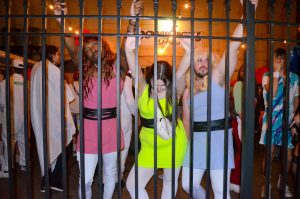Guest Column: Secret chemical tests deserve more scrutiny
April 7, 2013
They went block by block, covering a lot of territory. My mother told us it was the government spraying for mosquitoes and to stay away from the mist.
Other kids in the mostly black community ran behind the slow-moving vehicles having a good time trying to keep up. It seemed harmless, like chasing an ice cream truck in the crowded low-income neighborhood.
Where the government was involved with poor blacks then, little was “innocent” or “good.” The Tuskegee syphilis experiment is an example of untreated black men being studied for decades to chart the progression of the disease.
Another involved Henrietta Lacks, a black woman, who was diagnosed in 1951 with cervical cancer. Without telling her, doctors took a piece of her tumor to study with cells growing long after she’d died. The infinite growth aided medical research, but the family didn’t know anything about it for decades.
Last year the Associated Press and other news media reported that in the 1950s and 1960s the Army did secret chemical testing in impoverished black St. Louis neighborhoods. The Army used motorized blowers atop low-income high-rise housing, on schools and mounted on station wagons.
They sprayed a chemical substance called zinc cadmium sulfide, a fine fluorescent powder, into the air of the unsuspecting black community. It’s no April Fool’s Day joke. African Americans were unaware they were targeted for a biological Cold War weapons program.
St. Louis, where I was born and raised, was chosen because it seemed similar to cities in the former Soviet Union. At the time, the U.S. military wanted to be prepared to attack if the longstanding Cold War erupted into actual fighting. It wasn’t preposterous thought.
The United States came close to going to war with the Russians during the 1962 Cuban missile crisis. Kids of the baby boom were mostly clueless.
But we went through the endless civil defense drills. We did useless “duck and cover” exercises and went into school hallways for greater “protection” against a nuclear blast. We didn’t know.
The black community also sheltered us from discrimination’s bombardment. We learned later that unlike the Cold War threat, racism was real and deadly.
The Tuskegee experiment and Lacks’ case showed that blacks were exploited in medical testing often without their knowledge. It’s not surprising that St. Louis professor Lisa Martino-Taylor has raised concerns about the Army’s testing on unsuspecting black St. Louis residents.
The tests occurred as the civil rights movement was occurring. The Supreme Court in 1954 outlawed legal segregation. But its legacy persists today with inferior schools, unsafe housing, poor health care, low-paying or no jobs, and few opportunities to go to college.
During the Great Migration thousands of blacks left the oppressive South for opportunities and freedom in cities like St. Louis and Kansas City in the North. But that also exposed more people to abuse, as occurred in St. Louis.
Military officials said repeated tests showed the Cold War chemical program posed no health risks to residents. However, Sens. Claire McCaskill and Roy Blunt are right to seek more information.
The Cold War became an excuse for U.S. political and military leaders to make bad decisions. But it does not excuse our government from exposing thousands of black people to some chemical element that could have created a biological time bomb doing harm to folks right now.
It makes me wonder what else might have been done to poor black people in the name of protecting the rest of America. I hope the truth surfaces instead of folks shrugging it off to history and the way things were.
Lewis W. Diuguid is a member of The Kansas City Star’s Editorial Board.








